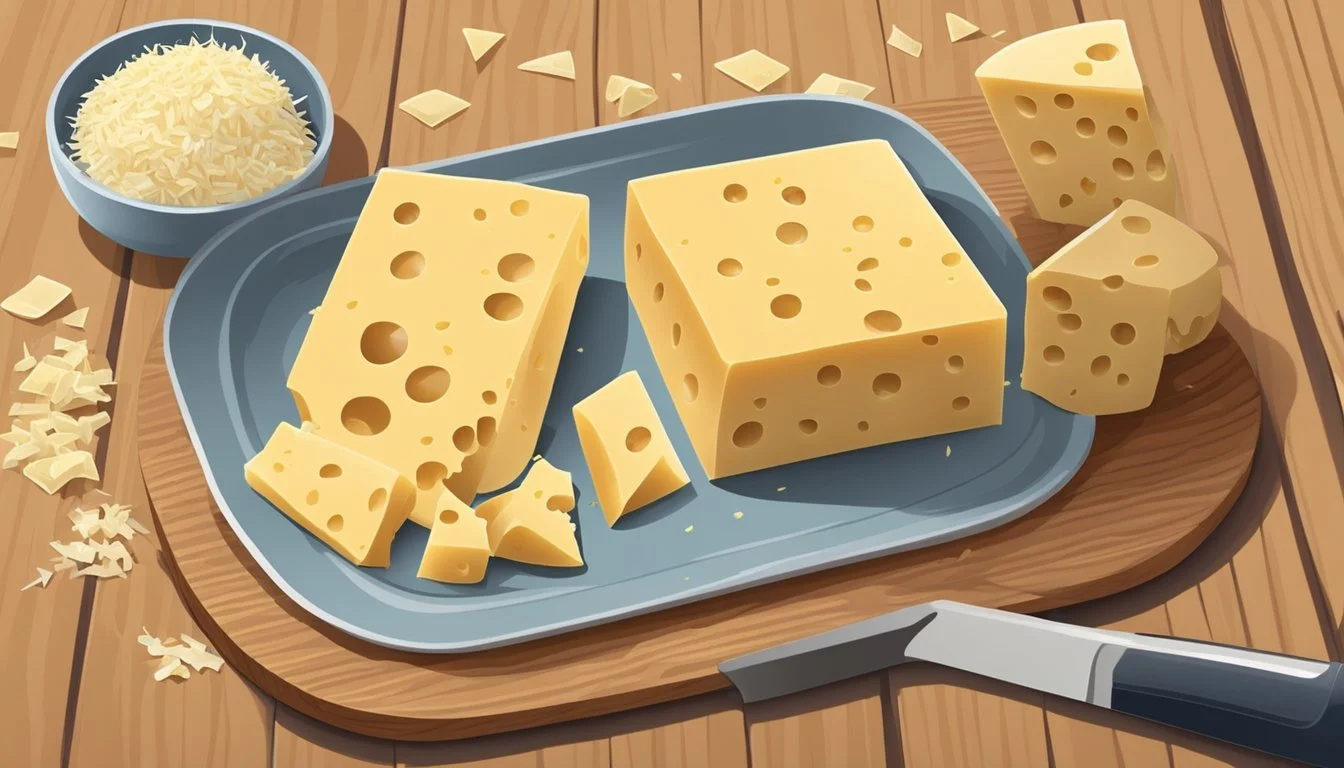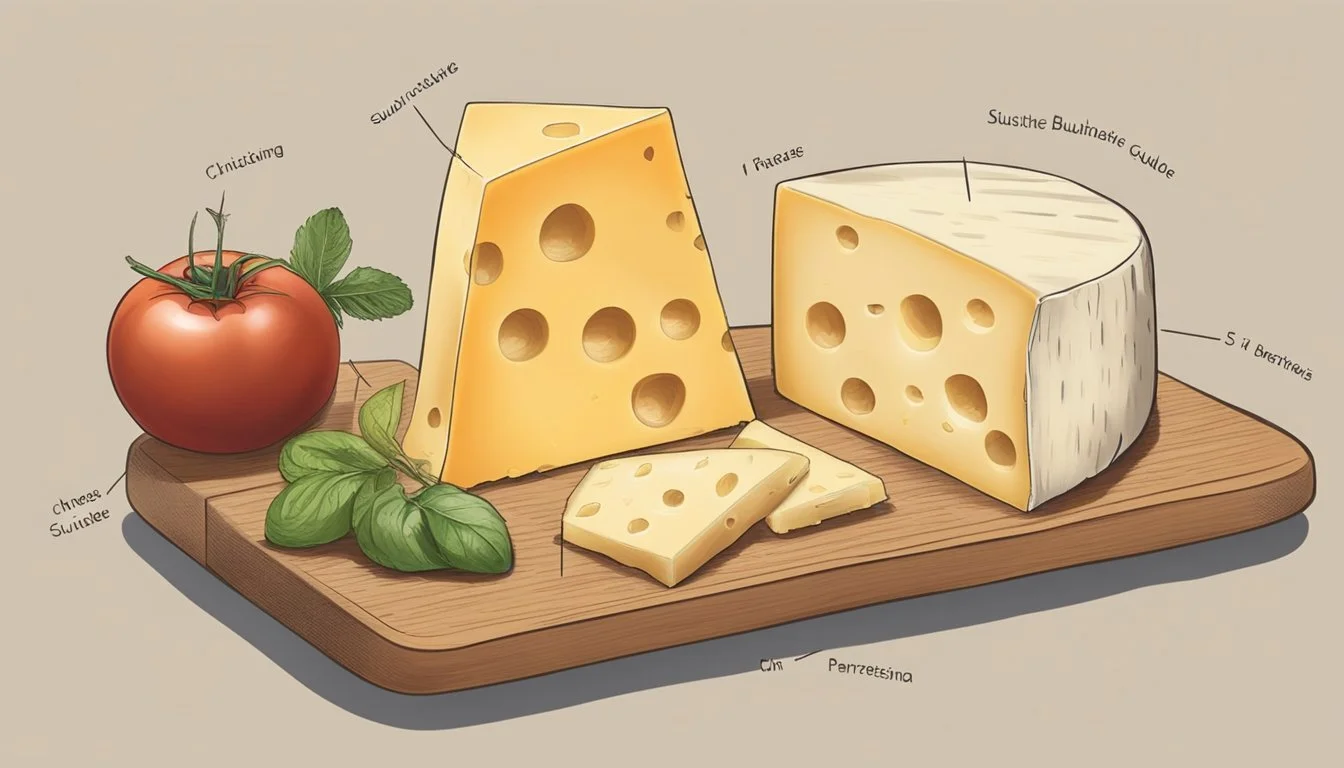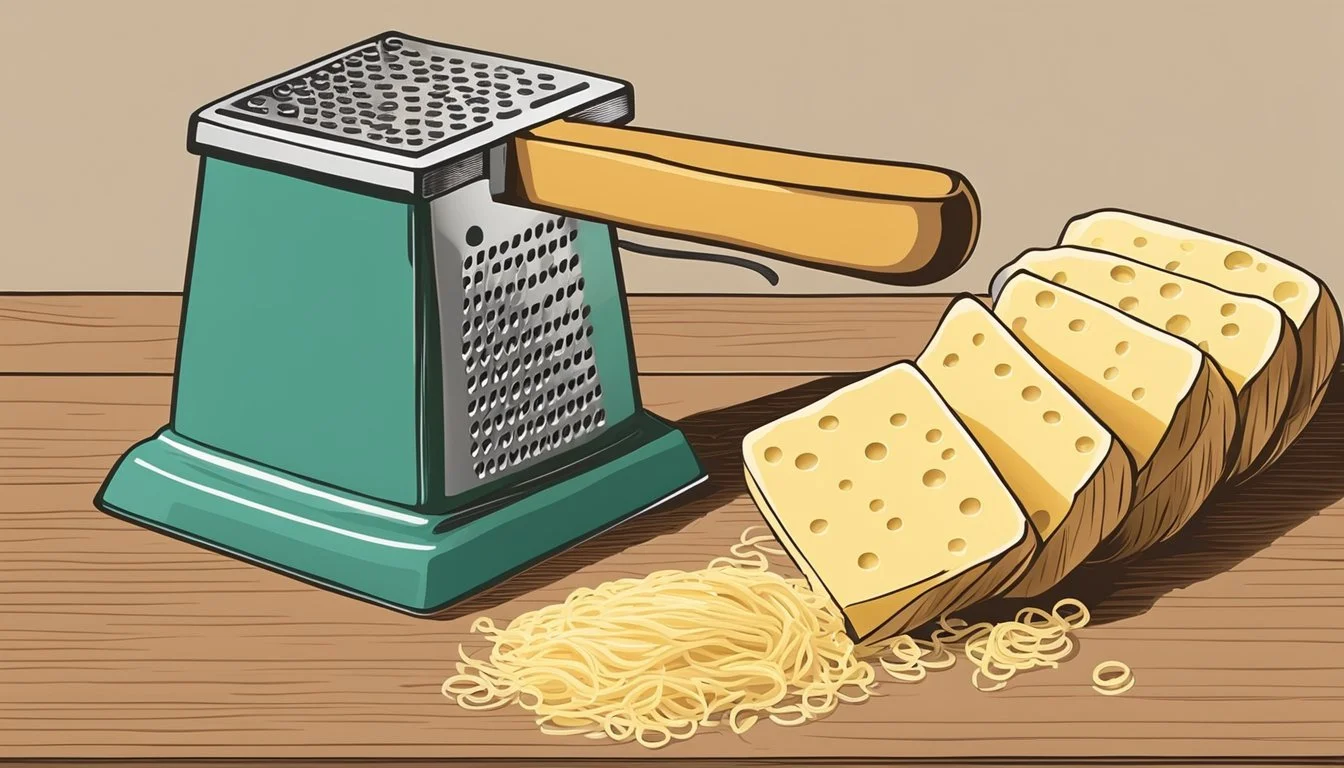How to Substitute Manchego Cheese for Parmesan in Your Recipes
Manchego cheese (What wine goes well with cheese?), originating from the La Mancha region of Spain, is revered for its rich taste and creamy texture, making it a favored ingredient in various dishes. However, there might be situations when this sheep's milk cheese isn't available, or a recipe specifically calls for the unmistakable flavor of Parmesan cheese. Substituting Manchego for Parmesan requires understanding the sensory and functional qualities that Parmesan brings to dishes. Parmesan, known for its granular texture and salty, nutty flavor, is often used to add a depth of flavor to pastas, risottos, and soups.
When using Manchego as a stand-in, one should select a Manchego that is aged, as it presents a closer consistency to that of Parmesan. The aim is to achieve a similar melting quality and umami profile that Parmesan provides. While Manchego is milder and less salty compared to Parmesan, it still offers a complexity that can complement a dish in a similar manner. Chefs may consider increasing the amount of salt or the nuttiness in the recipe to more closely mimic the presence of Parmesan.
The choice to substitute Manchego cheese for Parmesan is not only a matter of matching textures and flavors but also understanding the role Parmesan plays in a dish. It enhances umami and provides a savory underlying note that balances out the flavors. By being mindful of these characteristics, one can use Manchego effectively as a Parmesan substitute and still produce a dish that maintains the integrity of the intended flavor profile.
Understanding Cheese Characteristics
When substituting Manchego cheese for Parmesan, one must consider the nuances in flavor, texture, maturation, and nutritional content that characterize these two types of cheese.
Flavor Profiles of Parmesan and Manchego
Parmesan: Known for its intense flavor profile, it is salty, nutty, and features a subtle sweetness. Parmesan, an Italian cheese, is often described as having a complex taste that lingers on the palate.
Manchego: This Spanish cheese offers a less assertive flavor than Parmesan. It also has a sweet, nutty essence, but it is milder and not as intense. The flavor can be described as well-balanced and smooth.
Comparing Textures: Crumbly vs Creamy
Parmesan: Exhibits a hard, crumbly texture, making it ideal for grating. The dryness of this cheese is due to its low moisture content.
Manchego: Generally has a creamy texture, particularly when it is young. While it hardens with age, it typically remains less crumbly than Parmesan.
Aging Process and Cheese Maturity
Both cheeses undergo an aging process that affects their flavor and texture.
Parmesan: It is aged for a minimum of 12 months and can be aged up to 36 months. The longer aging time intensifies its flavor and makes it crumblier.
Manchego: It can be aged from 60 days to two years. Younger Manchego will be softer and milder, whereas the flavor becomes sharper and the texture firmer as it matures.
Nutritional Content: Protein, Calcium, Vitamins
Cheese is a dense source of protein and calcium, and both Parmesan and Manchego are no exception. They also contain vitamin A.
Parmesan: High in calcium and protein, providing a rich source of nutrients. It also contains a significant amount of vitamin A.
Manchego: Nutritional content varies with age but generally contains a similar amount of protein and calcium. It is also a good source of vitamin A, although typically lower in content than Parmesan.
Culinary Uses and Pairings
When substituting Manchego for Parmesan cheese, the textural differences and milder flavor profile of Manchego should be considered to maintain balance within the dish's flavor profile.
Pairing with Pasta, Pizza, and Salads
Pasta Dishes: Manchego cheese provides a creamy and slightly sweet contrast when grated over pasta, especially those with light sauces. For robust Italian sauces often paired with Parmesan, they should use Manchego judiciously as it is less sharp.
Pizza: On pizzas, Manchego can offer a subtle twist with its nutty notes. Given its good melting qualities, thin slices work well, especially on pizzas with a Spanish flair.
Salads: Salads benefit from Manchego's mild sweetness. It's advisable to shave Manchego over salads for a succulent burst of flavor that doesn't overpower the greens and other fresh ingredients.
Manchego in Sandwiches and Quesadillas
Sandwiches: Manchego's ability to complement both savory and sweet makes it a dynamic choice for sandwiches, melding particularly well with cured meats or fig jam.
Quesadillas: In quesadillas, they can use Manchego as a less intense alternative to Parmesan. Its excellent melting quality and mild taste pairs nicely with spicy, zesty fillings.
Choosing Cheese for a Cheeseboard
For a cheeseboard, Manchego brings a Spanish touch that can pleasantly accompany other cheeses. To honor the milder nature of Manchego in contrast to the robustness of Parmesan, pairing it with light crackers, quince paste, and a selection of nuts accentuates its character.
Substitutes and Alternatives
When considering substitutes for Manchego cheese in recipes that traditionally call for Parmesan, it's crucial to look for cheeses with a similar texture, flavor profile, and melting behavior.
Finding the Perfect Manchego Substitute
When one is looking to replace Manchego with a cheese that shares its mild and nutty features, Monterey Jack cheese rises as a prime candidate. Originating from California, Monterey Jack boasts a creamy and semi-firm texture, while its subtle sweetness pairs well with many dishes that would typically involve Manchego.
Exploring Cheese Types for Substitution
A variety of cheeses can step in as substitutes for Manchego:
Asiago Cheese: With a flavor that intensifies with age, Asiago offers a slightly sweet and tangy profile.
Romano and Pecorino Romano: Known for their sharp and salty flavor, these cheeses add a robust character to dishes.
Muenster Cheese: This American cheese presents a smooth texture and a mild flavor, making it a versatile substitute.
Cheese Type Flavor Profile Best Used In Asiago Cheese Sweet, tangy Grating over pasta and salads Romano Sharp, piquant Soups, sauces, and baked dishes Pecorino Romano Bold, salty Hearty dishes requiring a strong cheese flavor Muenster Cheese Mild, smooth Melting in sandwiches and burgers
Vegetarian and Vegan Alternatives
For those seeking a non-dairy alternative to Manchego, several plant-based options exist:
Cashew Cheese: Cashew-based cheeses offer a creamy texture and are often infused with nutritional yeast for a cheesy flavor.
Tofu: Tofu can be crumbled and seasoned to mimic the texture and taste of grated cheese.
Soy Parmesan: Specifically designed to replace Parmesan, soy-based cheese alternatives provide a similar taste profile for those avoiding dairy.
It is important to note that texture and melting qualities may vary with vegan alternatives, and they may not replicate the exact qualities of Manchego or Parmesan cheese. However, they provide a suitable option for those adhering to vegetarian or vegan dietary restrictions.
Cheese Selection Guide
When substituting Manchego cheese for Parmesan, one must match the cheeses accurately in intensity, balance flavors harmoniously, and consider their visual and aromatic properties.
Selecting Cheeses with Matching Intensities
Choosing a cheese that matches the intensity of Parmesan is crucial for ensuring flavor harmony in a dish. Parmesan is well-known for its salty and intense flavor profile. In comparison, one should seek a substitute with a similar level of savory punch to maintain the expected taste experience of the original recipe.
Manchego: Aged for a balance of intenseness
Parmesan Substitute: Choose a variety with equivalent aging to Manchego
Balancing Cheese Flavors in Dishes
The balance of flavors in a dish contributes significantly to its overall appeal. A chef must thoughtfully pair the substitute cheese with other ingredients, ensuring that the milky taste and savory qualities are well-matched and complement, rather than overpower, the other components.
Milky Taste: Consider the richness of the substitute
Savory Flavor: Ensure the substitute carries enough savory notes
Visual and Aromatic Cheese Qualities
Both visual appeal and aroma are key aspects of cheese that can affect the enjoyment of food. Cheese used as a garnish or main ingredient should closely resemble the appearance and scent of Parmesan to meet diner expectations.
Visual: Aim for similar color and texture
Aroma: Select a cheese with a comparable scent profile, which should be nutty and rich without being too overpowering
Regional Cheese Varieties
This section delves into regional cheese varieties essential for understanding the unique characteristics of Manchego from Spain and Parmesan from Italy, including their cousins and possible substitutions from American and international cheeses.
Italian Delicacies: Parmesan and Its Cousins
In Italy, Parmesan is a term often associated with Parmigiano-Reggiano, a hard, granular cheese known for its rich flavor and granular texture. It is made from cow's milk and aged between 12 and 36 months. Notably, Grana Padano and Piave serve as close relatives to Parmesan, offering similar flavor profiles with slightly different aging processes.
Spanish Stars: Manchego and Zamorano
Manchego, or Queso Manchego in English, hails from Spain's La Mancha region and is a product of the milk from Manchega sheep. It has a distinctive taste and firmer texture, not as granular as Parmesan but still crumbly. Another Spanish treasure, Zamorano cheese, shares similarities with Manchego but comes from the milk of the Churra and Castellana sheep, offering a slightly different flavor and texture profile.
American and International Cheese Types
The United States and other regions around the globe offer their own alternatives that can stand in for Manchego. Notable substitutes include Monterey Jack, which, although derived from cow's milk, provides a similar texture and a buttery flavor. On the other hand, Pecorino Romano, an Italian cheese now also produced internationally, offers a saltier and more intense flavor, making it a good alternative for those looking to replace Parmesan in recipes.
Preparing Cheese at Home
When substituting Manchego cheese for Parmesan, one may opt to prepare the cheese at home to achieve the desired creamy and buttery textures that complement many dishes.
Home Aging Techniques for Cheese Enthusiasts
The process of aging cheese at home begins with selecting the right base cheese that can be developed to exhibit a creamy and mild flavor profile similar to Manchego. Cheese enthusiasts might choose young, semi-hard cheeses with a natural propensity for aging into a creamier consistency.
Cheese cave or dedicated refrigerator that can maintain a consistent temperature
Humidity control tools such as a hygrometer
Cheese wax or wrapping for protection
Aging Steps:
Begin by selecting a base cheese such as a young Monterey Jack or Gouda for their buttery texture.
Control the environment in which the cheese ages, targeting a temperature between 10°C and 15°C (50°F and 59°F) and humidity at 80% to 85%.
Develop the rind by turning the cheese regularly and applying wax or a wrap to retain moisture and encourage even aging.
Monitor the cheese's maturation regularly, checking for consistency in texture and flavor development.
Through careful maintenance and patience, a cheese with a creamy consistency and flavor akin to Manchego can be achieved, offering a suitable substitute for Parmesan in various recipes.
Health Considerations When Substituting Cheese
Substituting Manchego with Parmesan cheese requires attention to dietary restrictions and nutritional content. This section helps identify health-related factors one should be aware of when making cheese substitutions.
Allergies and Lactose Intolerance Considerations
When selecting a substitute for Manchego cheese, individuals with food allergies should consider the potential presence of allergens. Both Manchego and Parmesan are derived from milk and thus contain lactose and milk proteins, which can provoke allergic reactions in sensitive individuals.
For those dealing with lactose intolerance, it is worth noting that aged cheeses like Parmesan and Pecorino Romano tend to have lower lactose content compared to less matured, milder cheeses. The aging process reduces lactose levels, making these cheeses potentially more tolerable for lactose-intolerant individuals.
The nutritional profiles of Manchego and Parmesan also differ in fat, calorie, and sodium content. Parmesan is rich in calcium and protein but is also higher in sodium. Substituting in a recipe could slightly alter one's intake of these nutrients. Adhering to recommended serving sizes and considering the overall dietary context can help manage these concerns efficiently.
Conclusion
When one wishes to substitute Manchego cheese for Parmesan, understanding the texture and flavor profile of each cheese is essential. Manchego, with its nutty and subtle sweetness, serves as a viable replacement for Parmesan in many dishes.
Cheese Types as Substitutes:
Mild Cheese Varieties: These are ideal when a recipe calls for a less dominant cheese flavor.
Nutty Cheeses: These can offer a complexity similar to Parmesan.
Aged Cheeses: These often possess the depth of flavor desirable for dishes typically featuring Parmesan.
Suitable Manchego Substitutes:
Monterey Jack: It has a creamy texture and mild flavor, making it an effective substitute.
Mozzarella: Especially when aged, mozzarella can mimic the texture and taste profiles desired.
To achieve a satisfactory result when substituting Manchego for Parmesan, it is advised to consider the salt content and adjust seasoning in the dish accordingly. Each substitution should be tested in small quantities beforehand, ensuring the final dish maintains the intended flavor balance.
Manchego substitutes can indeed provide a pleasant alternative to Parmesan, expertly enhancing a meal's profile under the right circumstances. Chefs and home cooks alike should feel confident experimenting with these substitutions to tailor dishes to their specific tastes and ingredient availability.





